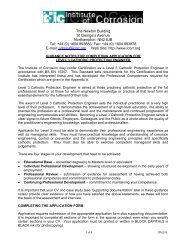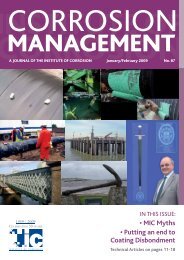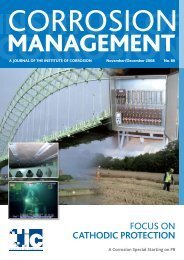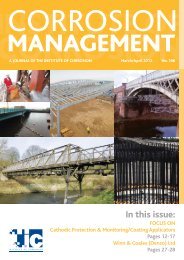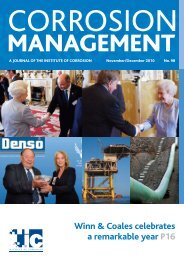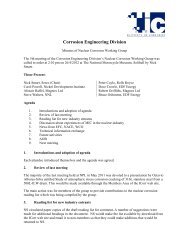Full Programme Pages 8 & 9 Register online at www.correx.org
Full Programme Pages 8 & 9 Register online at www.correx.org
Full Programme Pages 8 & 9 Register online at www.correx.org
- No tags were found...
Create successful ePaper yourself
Turn your PDF publications into a flip-book with our unique Google optimized e-Paper software.
CorrosionManagement | September/October 2009TECHNICALARTICLEModelling the electrochemical remedi<strong>at</strong>ionof steel framed heritage structuresSuperstructures, 32 Avenue of the Americas, New York, NY 10013, USAAuthor: Yu-You WuAbstract: The problem of damage to historicsteel framed structures as a result of corrosionis now widely recognised in Western Europe,America and Australia. Structures built inthe l<strong>at</strong>e 19th or early 20th century are <strong>at</strong>gre<strong>at</strong>est risk, together with earlier buildingsth<strong>at</strong> have received modific<strong>at</strong>ions or structuralinterventions during this period. Traditionalmethods of repair are often too intrusive andtoo expensive to consider. As a consequence anumber of important structures are <strong>at</strong> risk ofincurring extensive damage to their stone andfaience finishes th<strong>at</strong> may require replacementwith new, non-original elements. C<strong>at</strong>hodicprotection (CP) has been seen as a possibleelectrochemical solution to the problem ofsteel frame corrosion and has been in use inthe UK and elsewhere for several years. In theabsence of formal guidance and standards,most install<strong>at</strong>ions rely on the skill andexperience of the designers and installers toensure effective remedi<strong>at</strong>ion.To assist in the development of such guidelines,the Royal Society has supported a four yearresearch programme into the use of CP onhistoric structures, carried out <strong>at</strong> the Centrefor Infrastructure Management <strong>at</strong> SheffieldHallam University. This paper describes thecompleted study, its results and conclusionsand shows how modelling of the processeshas helped identify the key factors in thesuccessful applic<strong>at</strong>ion of this technique toachieve maximum protection with minimumdisruption to the original structure.Keywords: steel framed structures, metalliccorrosion, numerical modelling, c<strong>at</strong>hodicprotection.1. IntroductionThe identific<strong>at</strong>ion of “Regent Street Disease”in the l<strong>at</strong>e 1970’s first highlighted theproblems of steel frame corrosion occurringon the grand and often listed structuresin the centres of many cities. This form ofconstruction, first employed in Chicago andsubsequently used in most major westerncities in the first two decades of the 20thcentury, has resulted in serious consequenceswith respect to serviceability, sustainability,safety and aesthetics. C<strong>at</strong>hodic protection,originally developed by Humphry Davy [1]and l<strong>at</strong>er employed widely on buried and10submerged structures, was first consideredfor reinforced concrete in the l<strong>at</strong>e 1950’s. Itwas not until the development of improvedanode systems based on c<strong>at</strong>alysed titaniumand titanium oxide in the early 1980’s andthe considerable advances in digital oper<strong>at</strong>ingsystems th<strong>at</strong> it became a serious commercialsolution.The transfer to steel framed buildings wassomewh<strong>at</strong> slower and it was not until 1997th<strong>at</strong> full structures such as Gloucester RoadUnderground St<strong>at</strong>ion [2], were protected bysuch systems. Even now, with several sizeableinstall<strong>at</strong>ions in the UK and others appearingworldwide, there are no formal guidelinesfor the design, install<strong>at</strong>ion and oper<strong>at</strong>ionof such systems. Most of the knowledge isbased on empirical observ<strong>at</strong>ion, lacks depthof understanding and is in the hands of a verysmall number of specialists.The aim of the Royal Society funded researchprogramme was to return to first principalsin the evalu<strong>at</strong>ion of the corrosion processesinvolved in the disruption of structuresincorpor<strong>at</strong>ing steel frames and how it canbe controlled through the use of c<strong>at</strong>hodicprotection. Numerical modelling of thec<strong>at</strong>hodic protection currents was developedin parallel with practical studies employingsand to represent the electrolytic propertiesof masonry. From these models it has beenpossible to both better understand theprocesses occurring and develop optimiseddesigns for the protection of such structureswith minimal intervention.2. Corrosion processes insteel framed structuresSteel framed masonry clad constructionbecame popular around the turn of the 20thcentury and many of the grand commercialand municipal buildings found in Europeancity centres constructed between 1900 and1940 employed this form of construction(see Figure 1). The steel frames weregenerally dependent upon the quality of theirencapsul<strong>at</strong>ion to prevent corrosion. Oftenthey would have a cement wash or bitumenemulsion co<strong>at</strong>ing but this was only intendedto be a holding primer to prevent corrosionduring transport. Over the last 75 to 100Figure 1: Steel frame construction circa1939.years, the protection has broken down and thesteel has corroded, resulting in cracking anddisplacement of masonry as the high volumecorrosion has filled up the gaps between theframe and the cladding, as shown in Figure 2.In extreme cases, the steel members have lostsufficient section to impair their structuralcapacity, requiring the inclusion of new oradditional steel. In the presence of moistureand oxygen, steel and other simple ferrousalloys undergo corrosion resulting in a lossof metal and the form<strong>at</strong>ion of expansivecorrosion products commonly referred toas rust. The r<strong>at</strong>e and n<strong>at</strong>ure of the processFigure 2: Corrosion of steel frame resulting indisplacement of masonry.



